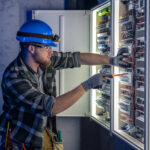Ever plugged in a blow dryer, then suddenly boom! Half your house is in the dark with no power?! You then go to the drawer where the flashlights are, and you find the electrical distribution panel, which is usually hidden behind a doorknob or somewhere in your basement. That’s where the circuit breaker lives — and you quickly locate the one switch that looks different from all the others, flip it, and boom — light! After that, you learnt better than to turn on that blow dryer with everything else plugged in at the same time — but why is that?! What actually caused that to happen?! Well, the breaker tripped! Today, we are going to discuss what a circuit breaker is, why they are needed, and how they work!
What Is a Circuit Breaker?
A circuit breaker is an electromechanical device that protects electrical systems in distribution boards. It interrupts electrical circuits when the rating of the current exceeds its defined limits as designed, which avoids damaging equipment and loss of power. At Solid Power Inc., we understand how annoying it can be to have an overloaded circuit, and that is precisely why we have Circuit Breakers to have a safe, effective electrical system.
How Circuit Breakers Work: Ensuring Safety Through Innovation
A circuit breaker operates by using a thermal-magnetic trip unit that continuously monitors the current flowing through the breaker. If a fault occurs, the trip unit will activate the trip mechanism mechanically, so that the electrical contacts are separated quickly to eliminate the supply of electricity.
Stay with us if you want to find out how a circuit breaker works!
- Monitors current flow internally
When electricity flows through the breaker, an internal trip unit constantly tracks the running current. When the circuit is operational normally, the contacts of the breakers stay closed and currents flow.
- Triggers a thermal trip
When there is a slow overload. The current increases sufficiently to heat a bimetallic strip. The strip bends at high enough temperatures to trigger a latch and separate contacts to open the circuit.
- Initiates a magnetic trip
In the event of a sudden high current short circuit. An electromagnet (solenoid coil) in the breaker generates a magnetic field instantaneously. The magnetic field pulls on a plunger to trigger the latch, which trips the breaker immediately.
- Disconnects and extinguishes the arc
Once the trip latch is released, an internal spring mechanism forces the electrical contacts apart to break the circuit. Thereafter, a cool arc chute cools the arc and disperses the arc to prevent fire.
- Requires manual reset
After the breaker has tripped, the breaker stays in the central “off” position until manually reset. Manually moving the handle to the full “off” position and back to “on” returns power by re-engaging the internal latch.
Why Circuit Breakers Matter: Safeguarding Against Electrical Hazards
A circuit breaker’s primary purpose is to act as a crucial safety device, safeguarding electrical systems and occupants from the dangerous consequences of electrical faults like overloads, short circuits, and ground faults. Its function is to prevent fires, equipment damage, and electrical shocks.
Keep reading to know the purpose of circuit breakers in our lives:
- Protects against overloads: Circuit breakers prevent wires from overheating by tripping when too many devices are plugged in, avoiding fire hazards.
- Safeguards against short circuits: These devices trip instantly when a hot wire touches a neutral or ground wire, minimizing arcing and fire risk.
- Detects deadly ground faults: Ground Fault Circuit Interrupters (GFCIs) identify imbalances in current flow, crucial for preventing electrocution in wet areas.
- Provides a reusable safety switch: Unlike fuses that need replacement, tripped circuit breakers can be reset, offering a reliable long-term solution.
- Allows for manual electrical control: Circuit breakers serve as manual switches to turn off power during maintenance, enhancing safety for users and electricians.
Conclusion
Circuit breakers are more than just important safety devices — they are hidden champions of our electrical world. Circuit breakers save lives by reducing the risk of electric fires and equipment damage by automatically disconnecting the supply in the event of an overload, short circuit, or ground fault. It also have the unique capability of providing a resettable and reusable option versus fuses. So when next you reset a tripped breaker or throw a switch, appreciate that you are restoring not just power but protecting your homes and loved ones from tragedy. Take strength in circuit breakers and maintain a safe and secure electrical environment!
FAQs
- What is the average cost to install a circuit breaker?
Installation costs typically range from $150 to $300 per breaker, including labor. - How long does it take to replace a circuit breaker?
Replacing a single breaker usually takes about 1 to 2 hours; more complex jobs may take longer. - Can I reset a tripped circuit breaker myself?
Yes, you can manually reset a circuit breaker once the issue has been resolved. - How often should circuit breakers be inspected?
Every 1–3 years by a licensed electrician to ensure safety and prevent failures. - What are the signs that my circuit breaker needs replacement?
Frequent tripping, burning smells, buzzing sounds, or visible damage around the breaker box.



